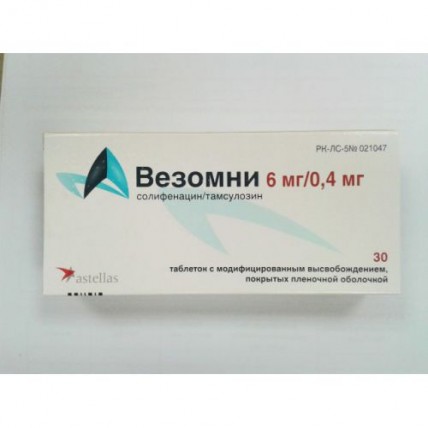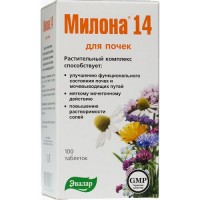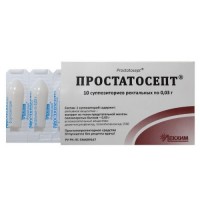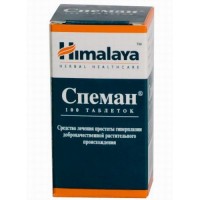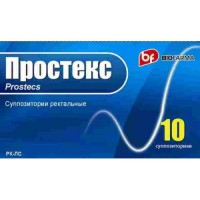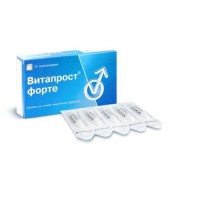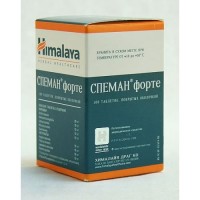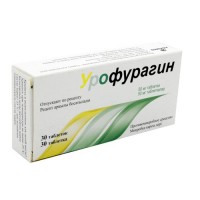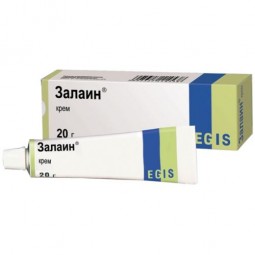Vezomni 6 mg / 0.4 mg 30s modified release tablets
- $85.00
Sku:
2fe3f51af8b4
The instruction for medical use of Vezomni Torgovoye medicine Vezomni Mezhdunarodnoye's name the unlicensed name Is not present the Dosage form of the Tablet with the modified release, film coated 6 mg / 0.4 mg Structure One tablet contains active agents: solifenatsina succinate of 6 mg, tamsulozina hydrochloride of 0.4 mg, excipients: Mannitolum, a maltose, magnesium stearate, a macrogoal 7,000,000, a macrogoal 8000, water purified structure of a cover of a tablet: Opadray red 03F45072 (a gipromelloza of 6 MPas - with, ferrous oxide red (E172), a macrogoal 8000). The description Round tablets film coated red color, with an engraving 6/0.4. Pharmacotherapeutic group Drugs for treatment of urological diseases. Drugs for treatment of a benign hypertrophy of a prostate. Alpha adrenoblockers. Tamsulozin and solifenatsin. The ATX G04CA53 code the Pharmacological Pharmacokinetics Absorption Later properties of multiple dose of Vezomni time of achievement of the maximum concentration (tmax) for a solifenatsin varied between 4.27 h and 4.76 h in different researches, for a tamsulozin - between 3.47 h and 5.65 h respectively. The maximum concentration in plasma (Cmax) for a solifenatsin varied between 26.5 ng/ml and 32.0 ng/ml, for a tamsulozin - between 6.56 ng/ml and 13.3 ng/ml. The value of the area under a curve concentration time (PPK) for a solifenatsin varied from 528 ngch/ml up to 601 ngch/ml, for a tamsulozin – between 97.1 ngch/ml and 222 ngch/ml. The absolute bioavailability for a solifenatsin is about 90% while tamsulozin it is absorbed for 70-79%. Removal After single dose of Vezomni time of semi-removal (t1/2) for a solifenatsin varies of 49.5 h to 53.0 h, for a tamsulozin – of 12.8 h to 14.0 h. Information on pharmacokinetics of active agents of the combined drug supplements pharmacokinetic Vezomni properties: Solifenatsin Absorbtion the Maximum concentration in plasma (Cmax) is reached in 3-8 hours. Time of achievement of the maximum concentration (tmax) does not depend on a dose. Cmax and the area under a curve concentration time (PPK) of dependence of concentration from time increase in proportion to increase in a dose from 5 to 40 mg. Absolute bioavailability - 90%. Distribution the Volume of distribution of a solifenatsin after intravenous administration makes about 600 l. Solifenatsin substantially (about 98%) is connected with proteins of plasma, mainly with α1-кислым a glycoprotein. Metabolism: Solifenatsin is actively metabolized by a liver, mainly an isoenzyme 3A4 (CYP3A4) of a system P450 cytochrome. However there are alternative metabolic paths by means of which metabolism of a solifenatsin can be carried out. The system clearance of a solifenatsin is about 9.5 l/hour, and final elimination half-life is equal to 45-68 hours. After administration of drug inside in plasma besides a solifenatsin the following metabolites were identified: one pharmacological active (4R-hydroksisolifenatsin) and three inactive (N-glucuronide, N-oxide and 4R-hydroxy-N-oxide of a solifenatsin). Removal: After single introduction of 10 mg of a 14C-marked solifenatsin 26 days later about 70% of radioactivity were revealed in urine and 23% in excrements. In urine about 11% of radioactivity about 18% in the form of a N-oxidic metabolite, 9% in the form of a 4R-hydroxy-N-oxidic metabolite and 8% in the form of metabolite 4R-hydroxy (active metabolite) are revealed in the form of not changed active agent. Tamsulozin Absorbtion For a tamsulozin in the form of OKAS absorption is estimated at 57% of the entered dose. Tamsulozin is characterized by linear pharmacokinetics. In an equilibrium state the concentration of a tamsulozin in plasma reaches peak in 4-6 hours. Distribution Communication with proteins of plasma – about 99%, the volume of distribution small (about 0.2 l/kg). Tamsulozin's metabolism is slowly metabolized in a liver with formation of less active metabolites. The most part of a tamsulozin is provided in blood plasma in not changed form. Tamsulozin is generally metabolized in a liver, mainly with participation of isoenzymes of CYP3A4 and CYP2D6. Removal After single dose of 0.2 mg of a 14C-marked tamsulozin in 1 week about 76% of radioactivity was revealed in urine and 21% in Calais. In urine about 9% of radioactivity were revealed in the form of not changed active agent, about 16% in the form of sulfate about-deetilirovannogo a tamsulozin, and 8% in a look about-etoksifenoksi acetic acid. Features of pharmacokinetics at separate categories of patients Elderly people In researches of clinical pharmacology and bioavailability the age of patients varied from 19 to 79 years. After Vezomni's use the highest rates of concentration were revealed at elderly patients though almost full coincidence to separate indicators of younger patients was observed. Vezomni can be used at elderly patients. The renal failure Vezomni's Pharmacokinetics was not studied for patients with a renal failure. The data provided below reflect information available on each component of drug concerning patients with a renal failure. Solifenatsin PPK and Cmax of a solifenatsin at patients with a slight and moderate renal failure slightly differ from the corresponding indicators at healthy volunteers. At patients with a heavy renal failure (clearance of creatinine of ≤30 ml/min.) the exposure of a solifenatsin is much higher - increase in Cmax is about 30%, PPK – more than 100% and t1/2 – more than 60%. The significant interrelation between clearance of creatinine and clearance of a solifenatsin is noted. The pharmacokinetics at patients to whom the hemodialysis is carried out, was not studied. Tamsulozin Bylo comparison of pharmacokinetics of a tamsulozin at 6 patients with an easy and moderate form (30 ≥ clearance of creatinine & lt, 70 ml/min. / 1.73м ²) or a moderate severe form (30ml/min/1.73 ²) a renal failure and at 6 healthy patients is carried out (clearance of creatinine of ≥90 ml/min. / 1.73м ²). While change of the general concentration of a tamsulozin in blood plasma as a result of change of communication with an alfa1-acid glycoprotein, active concentration of a tamsulozin of a hydrochloride was observed and also own clearance remained rather stable. The pharmacokinetics of a tamsulozin at patients with the last stage of a renal failure (clearance of creatinine & lt, 10 ml/min. / 1.73м ²) was not studied. The liver failure Vezomni's Pharmacokinetics was not studied for patients with a liver failure. The data provided below reflect information available on each component of drug concerning patients with a liver failure. Solifenatsin At patients with a moderate liver failure (7-9 points on a scale of Chayld-Pyyu) the size Cmax does not change, PPK increases by 60%, t1/2 doubles. The pharmacokinetics at patients did not decide on a heavy liver failure. Tamsulozin Bylo comparison of pharmacokinetics of a tamsulozin at 8 patients with a moderate liver failure (7-9 points on a scale of Chayld-Pyyu) and at 8 healthy patients is carried out. While change of the general concentration of a tamsulozin in blood plasma as a result of change of communication with an alfa1-acid glycoprotein was observed, active concentration of a tamsulozin of a hydrochloride considerably did not change, and own clearance of an inactive tamsulozin moderately changed (32%). The pharmacokinetics of a tamsulozin at patients with a severe form of a liver failure was not studied. The pharmacodynamics the Mechanism of action Vezomni is the combined drug which contains two active agents, solifenatsin and tamsulozin. These active agents have independent and complementary mechanisms of action at treatment of symptoms of the lower uric ways connected with a benign hyperplasia of a prostate in the presence of filling symptoms. Solifenatsin – a selection competitive inhibitor of muskarinovy receptors of a bladder, mainly m3 subtype, also has low or lack of affinity to various other receptors, enzymes and ion channels. Tamsulozin is an alfa1-adrenoblocker. It is a selection competitive blocker postsynaptic α1-адренорецепторов, especially α1А and α1D the subtypes which are responsible for relaxation of smooth muscles of the lower uric ways. Pharmakodinamichesky influence Solifenatsin facilitates symptoms of filling of a bladder (irritativny symptoms) connected with action of acetylcholine which activates m3-holinoretseptory in a bladder. Acetylcholine activates sokratitelny function of a wall of a bladder that is shown in the form of urgentny desires to urination or urine incontinences. Tamsulozin facilitates depletion symptoms (obstructive symptoms) by relaxation of smooth muscles of a prostate, a neck of a bladder and a prostatic part of an urethra. Also reduces filling symptoms. Clinical performance and safety Efficiency of drug was shown as a result of clinical trial of the III phase at patients with symptoms of the lower uric ways against the background of a benign hyperplasia of a prostate. At Vezomni's reception the significant reduction of symptoms on a scale of assessment of urgentny desires and frequencies of urination and also the general frequency of urination, the average volume of urine allocated for one urination and point on a subscale IPSS filling in comparison with tamsuloziny in the form of controlled release (OKAS) was noted. These improvements are followed by significant increase in an indicator of quality of life on a scale of IPSS and an indicator of quality of life according to the Questionnaire of assessment of expressiveness of symptoms of hyperactivity of a bladder. Besides, Vezomni did not concede to OKAS tamsulozin in reduction of symptoms at assessment of the general point on IPSS scale (p & lt, 0.001). Indications - treatment of symptoms of filling (irritativny symptoms), from moderated to severe (urgentny desires to urination, the speeded-up urination), and depletion symptoms (obstructive symptoms) connected with a benign hyperplasia of a prostate at men who have no adequate response to monotherapy. A route of administration and doses Adult men, including elderly patients. Inside, on 1 tablet of 1 times a day irrespective of meal. The maximum daily dose – 1 (one) tablet Vezomni (6 mg / 0.4 mg). The pill has to be taken entirely, it cannot be chewed as it can influence the prolonged release of active agent. Side effects of Vezomni can cause the side effects connected with m-holinoblokiruyushchim action of a solifenatsin, is more often than weak or moderate expressiveness. Most often during conduct of clinical trials using Vezomni it was reported about such side effects as dryness in a mouth (9.5%), a constipation (3.2%) and dyspepsia (including an abdominal pain – 2.4%). Dizziness (1.4%), illegibility of sight (1.2%), fatigue (1.2%) and ejaculation disorders belong to other general undesirable reactions (including a retgrogradny ejaculation – 1.5%). The sharp delay of urination (0.3%, are rare) is the most serious side effect which was observed during the Vezomni drug treatment at conduct of clinical trials. Below the column Frequency of Undesirable Reactions at Vezomni's Reception reflects the side reactions registered during clinical trial of the drug Vezomni in the table. The columns frequency of emergence of undesirable reactions of a solifenatsin and tamsulozin reflect undesirable reactions about which it was reported concerning separate components (data from instructions of medicines solifenatsin 5 and 10 mg and tamsulozin 0.4 mg respectively) and which can potentially arise at administration of drug of Vezomni. Frequency of side reactions is defined as follows: very often (≥1/10), it is frequent (≥1/100 to & lt, 1/10), infrequently (≥1/1000 to & lt, 1/100), is rare (≥1/10.000 to & lt, 1/1000), is very rare (& lt, 1/10.000), it is unknown (it is impossible to estimate on the basis of the available data). Chastota of emergence of NR at Vezomni Chastot's reception of emergence of NR of rather separate Solifenatsin active agents of 5 mg and 10 mg Tamsulozin of 0.4 mg of the Infection and an invasion of the Infection of urinary tract Infrequently Cystitis Infrequently of Disturbance from the immune system Anaphylactic reaction of Neizvestno * Disturbances of metabolism and food the Loss of appetite of Neizvestno * Neizvestno's Hyperpotassemia * Mental disturbances of the Hallucination Is very rare * Psychosis Very seldom * Brad Neizvestno * Disturbances from nervous system Dizziness Is Often rare * Often Drowsiness Infrequently the Dysgeusia Infrequently the Headache Seldom * Infrequently the Syncope Seldom of Disturbance from organs of sight Illegibility of sight Often Often Intraoperative instability of an iris of the eye of Neizvestno * Xerophthalmus Infrequently Neizvestno's Glaucoma * Disturbances from the cardiovascular Heartbeat Infrequently Tachycardia system like Neizvestno's pirouette * Lengthening of an interval of QT on Neizvestno's electrocardiogram * Fibrillation of auricles of Neizvestno * Neizvestno's Arrhythmia * Neizvestno's Tachycardia * Orthostatic hypotension Infrequently of Disturbance from respiratory organs, a thorax and mediastinum Rhinitis Infrequently Dryness in a nose Infrequently Neizvestno's Asthma * Neizvestno's Dysphonia * Disturbances from digestive tract Dryness in a mouth Often Very often Dyspepsia Often Often the Constipation Often Often Infrequently Nausea Often Infrequently the Abdominal pain Often of GERD Infrequently Diarrhea Infrequently Dryness in a throat Infrequently Vomiting Seldom * Infrequently Colic impassability Seldom the Coprostasis Seldom Intestinal impassability of Neizvestno * Discomfort in Neizvestno's stomach * Gepatobiliarny disturbances the Abnormal liver function of Neizvestno * Increase in level of liver enzymes of Neizvestno * Disturbances from skin and hypodermic cellulose of Naggers Infrequently Seldom * Infrequently Xeroderma Infrequently Pour Seldom * Infrequently Allergic rash Very seldom * Infrequently Stephens-Johnson Ochen's Syndrome seldom the Quincke's edema Very seldom * Seldom Multiformnaya an erythema Very seldom * Exfoliative dermatitis of Neizvestno * Disturbances from the musculoskeletal system Muscle weakness of Neizvestno * Disturbances from kidneys and urinary tract the Delay of urination of Neizvestno urination Difficulty Infrequently Renal failure of Neizvestno * Disturbances is rare from the reproductive system of Disturbance of an ejaculation Often Often the Priapism Very seldom Disturbances of the general state Fatigue Often Infrequently Peripheral hypostasis Infrequently the Asthenia Infrequently * were observed after drug registration. Because data were obtained by method of spontaneous messages during the period after registration, determination of frequency and relationship of cause and effect with reception of a tamsulozin and solifenatsin is represented difficult. Long-term data on Vezomni Vida's safety and frequency of undesirable reactions which were observed during treatment during 1 year by the drug Vezomni matched data which were observed during the 12 weeks research. Drug was well transferred, and the special undesirable reactions connected with long administration of drug were not revealed. Elderly people the Side effects arising at elderly people were similar on the effects arising at younger patients. Contraindications - hypersensitivity to active components of drug or to excipients - carrying out a hemodialysis - a heavy liver failure - a heavy renal failure or a moderate liver failure at simultaneous treatment by strong inhibitors of an isoenzyme CYP3A4, for example, ketokonazoly - presence of a serious gastrointestinal illness (including toxic megacolon), a myasthenia and closed-angle glaucoma and also risks of developing these diseases. - orthostatic hypotension - children's and teenage age up to 18 years Medicinal interactions Interaction with CYP3A4 and CYP2D6 inhibitors the Simultaneous use of a solifenatsin and ketokonazol (200 mg a day), powerful inhibitor of an isoenzyme CYP3A4, caused double increase in the area under a curve concentration time (further – PPK) a solifenatsina, and in a dose of 400 mg/day - triple increase. Simultaneous use of a tamsulozin with ketokonazoly in a dosage of 400 mg/day leads to increase in Cmax and PPK of a tamsulozin in 2.2 and 2.8 times respectively. As simultaneous introduction with strong CYP3A4 inhibitors, such as ketokonazol, ritonavir, nelfinavir and itrakonazo
and can lead to increase in influence as a solifenatsina and a tamsulozina, Vezomni should be used with care in combination with strong CYP3A4 inhibitors. Vezomni should not be given together with strong CYP3A4 inhibitors to patients at whom metabolism of CYP2D6 phenotypical is reduced, or that who already uses strong CYP2D6 inhibitors. The concomitant use of Vezomni with verapamil (moderate CYP3A4 inhibitor) leads to increase in Cmax and PPK of a tamsulozin by 2.2 times and to increase in Cmax and PPK of a solifenatsin approximately by 1.6 times. Co-administration of a tamsulozin with weak CYP3A4 inhibitor Cimetidinum (to 400 mg there are each 6 hours) led to 1.44 multiple increase in PPK of a tamsulozin while Cmax significantly did not change. Vezomni can be used together with weak CYP3A4 inhibitors. The concomitant use of a tamsulozin with strong CYP2D6 inhibitor paroksetiny (20mg/put) leads to increase in Cmax and PPK of a tamsulozin in 1.3 and 1.6 times respectively. As solifenatsin and tamsulozin are metabolized by CYP3A4 isoenzyme, pharmacokinetic interactions with CYP3A4 isoenzyme inductors are possible (for example, rifampicin). Other interactions Solifenatsin Solifenatsin can reduce effect of the medicines stimulating motility of digestive tract, for example, of Metoclopramidum and a tsizaprid. The researches in vitro showed what in therapeutic concentration solifenatsin does not inhibit isoenzymes of CYP1A1/2, 2B6, 2C8, 2C9, 2C19, 2D6, 2E1 or 3A4. Therefore it is improbable that solifenatsin will change clearance of drugs, metaboliziruyemy these isoenzymes. Reception of a solifenatsin did not cause changes of pharmacokinetics of R-warfarin or S-warfarin or their influence on a prothrombin time. Reception of a solifenatsin does not make impact on digoxin pharmacokinetics. Tamsulozin α1-адренорецепторов can result Co-administration of other blockers in hypotensive effect. Diazepam, propranolol, trikhlormetiazid, chlormadinon, amitriptyline, diclofenac, glibenclamide, simvastatin and warfarin do not change free fraction of a tamsulozin in plasma of the person of in vitro. In turn, tamsulozin also does not change free fractions of diazepam, propranolol, a trikhlormetiazid and chlormadinon. Diclofenac and warfarin can increase the clearance rate of a tamsulozin. At simultaneous use with furosemide some decrease in concentration is noted, however it does not demand change of a dose as concentration of drug remains within normal range. The researches in vitro showed what in therapeutic concentration tamsulozin does not inhibit isoenzymes of CYP1A1/2, 2C9, 2C19, 2D6, 2E1 or 3A4. Therefore it is improbable that tamsulozin will change clearance of drugs, metaboliziruyemy these isoenzymes. When assigning a tamsulozin together with atenolol, enalapril or theophylline of interactions it was revealed not. Patients should appoint special instructions With Vezomni's care with care with: - the heavy renal failure, - risk of a delay of urination, - with gastrointestinal obstructive diseases, - with risk of the lowered motility of digestive tract, - with hernia of an esophageal opening of a diaphragm, a gastroesophageal reflux and to the patients who are at the same time taking medicines (for example, bisfosfonata) which can cause or strengthen an esophagitis, - with peripheral neuropathy, - at patients with such risk factors as a syndrome of lengthening of an interval of QT and a hypopotassemia, observed prolongation of an interval QT and tachycardia like pirouette. Other reasons of frequent urination (heart failure or diseases of kidneys) have to be estimated prior to Vezomni's reception. If there is an infection of urinary tract, it is necessary to begin the corresponding antibacterial therapy. At some patients receiving treatment the solifenatsiny ambassador of registration of drug the anaphylactic reaction was noted. At development of anaphylactic reactions Vezomni's treatment has to be stopped and should not be resumed. As well as when using others α1-адреноблокаторов, at treatment tamsuloziny the lowering of arterial pressure which in rare instances can lead to an unconscious state in some cases can be observed. It is necessary to warn the patients beginning to accept Vezomni about need at the first symptoms of orthostatic hypotension (dizziness, weakness) to sit down or lie down and remain in this situation until signs do not disappear. At some patients who are accepting or earlier accepting a tamsulozin a hydrochloride during surgery concerning a cataract and glaucoma the development of a syndrome of intraoperative instability of an iris of the eye of an eye (syndrome of a narrow pupil) which can lead to complications during operation or in the postoperative period was noted. It is not recommended to begin Vezomni's therapy at patients to whom operation for a cataract or glaucoma is planned. The expediency of cancellation of therapy of Vezomni in 1-2 weeks prior to operation for a cataract or glaucoma is still not proved. During preoperative inspection of patients the surgeon and the ophthalmologist have to consider, accepts or whether this patient Vezomni accepted. It is necessary for preparation for a possibility of development during operation of a syndrome of intraoperative instability of an iris of the eye of an eye. Vezomni should be used with care in a combination with strong and moderate CYP3A4 inhibitors, for example, verapamil, ketokonazoly, ritonaviry, nelfinaviry, itrakonazoly. Drug should not be used at patients with disturbance of metabolism of an isoenzyme of CYP2D6 in a combination with strong CYP3A4 inhibitors or strong CYP2D6 inhibitors, for example, paroksetiny. Patients with a renal failure of Vezomni it can be applied by patients with a slight and moderate renal failure (КК>, 30 ml/min.), but with care patients should apply with a heavy renal failure (KK ≤ 30 ml/min.) for whom the maximum daily dose – one tablet of Vezomni (6 mg / 0.4 mg). Patients with a liver failure of Vezomni it can be applied by patients with a slight liver failure (point on a scale of Chayld-Pyyu ≤ 7). Patients with a moderate liver failure (7-9 points on a scale of Chayld-Pyyu) should take drug with caution (the maximum daily dose – one tablet of Vezomni (6 mg / 0.4 mg)). Vezomni's use is contraindicated to patients with a heavy liver failure (point on a scale of Chayld-Pyyu higher than 9). Pregnancy and the period of a lactation Vezomni's Drug is used only at men. Features of influence of medicine on ability to run the vehicle or potentially dangerous mechanisms of the Research of impact of drug of Vezomni on ability to run vehicles and to be engaged in potentially dangerous types of activity were not carried out. However the patient has to be informed on possible developing of dizziness, illegibility of sight, fatigue less often than drowsiness that he can have an adverse effect on ability to drive the car and to work with mechanisms. Overdose Symptoms: the overdose by a combination of a solifenatsin and a tamsulozin can be followed is heavy
to Develop
and can lead to increase in influence as a solifenatsina and a tamsulozina, Vezomni should be used with care in combination with strong CYP3A4 inhibitors. Vezomni should not be given together with strong CYP3A4 inhibitors to patients at whom metabolism of CYP2D6 phenotypical is reduced, or that who already uses strong CYP2D6 inhibitors. The concomitant use of Vezomni with verapamil (moderate CYP3A4 inhibitor) leads to increase in Cmax and PPK of a tamsulozin by 2.2 times and to increase in Cmax and PPK of a solifenatsin approximately by 1.6 times. Co-administration of a tamsulozin with weak CYP3A4 inhibitor Cimetidinum (to 400 mg there are each 6 hours) led to 1.44 multiple increase in PPK of a tamsulozin while Cmax significantly did not change. Vezomni can be used together with weak CYP3A4 inhibitors. The concomitant use of a tamsulozin with strong CYP2D6 inhibitor paroksetiny (20mg/put) leads to increase in Cmax and PPK of a tamsulozin in 1.3 and 1.6 times respectively. As solifenatsin and tamsulozin are metabolized by CYP3A4 isoenzyme, pharmacokinetic interactions with CYP3A4 isoenzyme inductors are possible (for example, rifampicin). Other interactions Solifenatsin Solifenatsin can reduce effect of the medicines stimulating motility of digestive tract, for example, of Metoclopramidum and a tsizaprid. The researches in vitro showed what in therapeutic concentration solifenatsin does not inhibit isoenzymes of CYP1A1/2, 2B6, 2C8, 2C9, 2C19, 2D6, 2E1 or 3A4. Therefore it is improbable that solifenatsin will change clearance of drugs, metaboliziruyemy these isoenzymes. Reception of a solifenatsin did not cause changes of pharmacokinetics of R-warfarin or S-warfarin or their influence on a prothrombin time. Reception of a solifenatsin does not make impact on digoxin pharmacokinetics. Tamsulozin α1-адренорецепторов can result Co-administration of other blockers in hypotensive effect. Diazepam, propranolol, trikhlormetiazid, chlormadinon, amitriptyline, diclofenac, glibenclamide, simvastatin and warfarin do not change free fraction of a tamsulozin in plasma of the person of in vitro. In turn, tamsulozin also does not change free fractions of diazepam, propranolol, a trikhlormetiazid and chlormadinon. Diclofenac and warfarin can increase the clearance rate of a tamsulozin. At simultaneous use with furosemide some decrease in concentration is noted, however it does not demand change of a dose as concentration of drug remains within normal range. The researches in vitro showed what in therapeutic concentration tamsulozin does not inhibit isoenzymes of CYP1A1/2, 2C9, 2C19, 2D6, 2E1 or 3A4. Therefore it is improbable that tamsulozin will change clearance of drugs, metaboliziruyemy these isoenzymes. When assigning a tamsulozin together with atenolol, enalapril or theophylline of interactions it was revealed not. Patients should appoint special instructions With Vezomni's care with care with: - the heavy renal failure, - risk of a delay of urination, - with gastrointestinal obstructive diseases, - with risk of the lowered motility of digestive tract, - with hernia of an esophageal opening of a diaphragm, a gastroesophageal reflux and to the patients who are at the same time taking medicines (for example, bisfosfonata) which can cause or strengthen an esophagitis, - with peripheral neuropathy, - at patients with such risk factors as a syndrome of lengthening of an interval of QT and a hypopotassemia, observed prolongation of an interval QT and tachycardia like pirouette. Other reasons of frequent urination (heart failure or diseases of kidneys) have to be estimated prior to Vezomni's reception. If there is an infection of urinary tract, it is necessary to begin the corresponding antibacterial therapy. At some patients receiving treatment the solifenatsiny ambassador of registration of drug the anaphylactic reaction was noted. At development of anaphylactic reactions Vezomni's treatment has to be stopped and should not be resumed. As well as when using others α1-адреноблокаторов, at treatment tamsuloziny the lowering of arterial pressure which in rare instances can lead to an unconscious state in some cases can be observed. It is necessary to warn the patients beginning to accept Vezomni about need at the first symptoms of orthostatic hypotension (dizziness, weakness) to sit down or lie down and remain in this situation until signs do not disappear. At some patients who are accepting or earlier accepting a tamsulozin a hydrochloride during surgery concerning a cataract and glaucoma the development of a syndrome of intraoperative instability of an iris of the eye of an eye (syndrome of a narrow pupil) which can lead to complications during operation or in the postoperative period was noted. It is not recommended to begin Vezomni's therapy at patients to whom operation for a cataract or glaucoma is planned. The expediency of cancellation of therapy of Vezomni in 1-2 weeks prior to operation for a cataract or glaucoma is still not proved. During preoperative inspection of patients the surgeon and the ophthalmologist have to consider, accepts or whether this patient Vezomni accepted. It is necessary for preparation for a possibility of development during operation of a syndrome of intraoperative instability of an iris of the eye of an eye. Vezomni should be used with care in a combination with strong and moderate CYP3A4 inhibitors, for example, verapamil, ketokonazoly, ritonaviry, nelfinaviry, itrakonazoly. Drug should not be used at patients with disturbance of metabolism of an isoenzyme of CYP2D6 in a combination with strong CYP3A4 inhibitors or strong CYP2D6 inhibitors, for example, paroksetiny. Patients with a renal failure of Vezomni it can be applied by patients with a slight and moderate renal failure (КК>, 30 ml/min.), but with care patients should apply with a heavy renal failure (KK ≤ 30 ml/min.) for whom the maximum daily dose – one tablet of Vezomni (6 mg / 0.4 mg). Patients with a liver failure of Vezomni it can be applied by patients with a slight liver failure (point on a scale of Chayld-Pyyu ≤ 7). Patients with a moderate liver failure (7-9 points on a scale of Chayld-Pyyu) should take drug with caution (the maximum daily dose – one tablet of Vezomni (6 mg / 0.4 mg)). Vezomni's use is contraindicated to patients with a heavy liver failure (point on a scale of Chayld-Pyyu higher than 9). Pregnancy and the period of a lactation Vezomni's Drug is used only at men. Features of influence of medicine on ability to run the vehicle or potentially dangerous mechanisms of the Research of impact of drug of Vezomni on ability to run vehicles and to be engaged in potentially dangerous types of activity were not carried out. However the patient has to be informed on possible developing of dizziness, illegibility of sight, fatigue less often than drowsiness that he can have an adverse effect on ability to drive the car and to work with mechanisms. Overdose Symptoms: the overdose by a combination of a solifenatsin and a tamsulozin can be followed is heavy
to Develop
